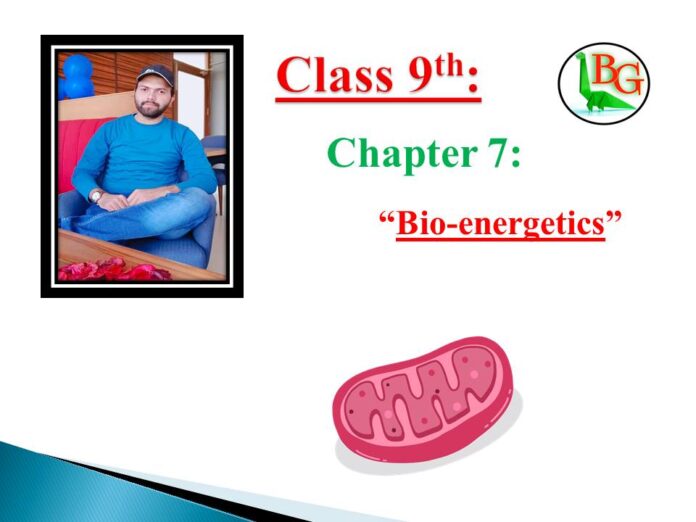
Class 9th Biology Bioenergetics MCQs and Questions
Chapter: 07
“Bio-energetics”
1. In living organisms which type of energy is used for future use?
a) Kinetic energy
b) Potential energy
c) Chemical energy
d) Thermal energy
Sol: (b) Potential energy
2. The study of energy relationships and energy transformation in living organisms is called
a) Bio-molecules
b) Bio-geoscience
c) Bio-energetics
d) Bio-physics
Sol: (c) Bio-energetics
3. The loss of electrons is called
a) Reduction
b) Oxidation
c) Oxidation-reduction
d) All of the above
Sol: (b) Oxidation
4. The gain of electrons is called
a) Reduction
b) Oxidation
c) Photosynthesis
d) None of the above
Sol: (a) Reduction
5. A reaction in which oxidation and reduction take place is called
a) Oxidation reaction
b) Oxidation-reduction reaction
c) Redox reaction
d) All of the above
Sol: (c) Redox reaction
6. Which substance can act as both an oxidized and reduced agent?
a) ATP
b) Hydrogen gas
c) Hydrogen Peroxide
d) Both (b) and (c)
Sol: (d) Both (b) and (c)
7. ATP was discovered in
a) 1829
b) 1929
c) 1729
d) 1329
Sol: (b) 1929
8. ATP was first discovered by
a) Muhammad Nasir
b) Karl Lohmann
c) Fritz Lipmann
d) None of the above
Sol: (b) Karl Lohmann
9. Who is the “father of the ATP cycle”
a) Karl Lohmann
b) Fritz Lipmann
c) Shielden
d) Darwin
Sol: (b) Fritz Lipmann
10. The main energy currency of all cells is a nucleotide
a) Hydrogen
b) Nitrogen
c) ATP (Adenosine triphosphate)
d) Ribose
Sol: (c) ATP (Adenosine triphosphate)
11. Each ATP molecule ha _______subunits.
a) One
b) Two
c) Three
d) Four
Sol: (c) Three
12. The ability of ATP to store and release chemical buy anavar energy is due to its
a) Chemical structure
b) Molecular structure
c) Primary structure
d) Secondary structure
Sol: (b) Molecular structure
13. How many phosphate groups are in the ATP structure
a) One
b) Two
c) Three
d) Four
Sol: (c) Three
14. The covalent bond connecting two phosphates are indicated by
a) Colon (:)
b) Tilde (̴)
c) Ratio (:)
d) Pi (π)
Sol: (b) Tilde
15. How much energy is released when one phosphate bond is breaking
a) 7300 calories
b) 7.3kcal
c) Both (a) and (b)
d) None of the above
Sol: (c) Both (a) and (b)
16. Photosynthesis is a
a) Catabolic process
b) Anabolic process
c) Metabolic process
d) None of the above
Sol: (b) Anabolic process
17. In which process “oxygen” is released as a by-product
a) Fermentation
b) Photosynthesis
c) Respiration
d) Diffusion
Sol: (b) Photosynthesis
18. Which reaction takes place on the thylakoid membranes of chloroplasts?
a) Light reaction
b) Dark reaction
c) Chemical reaction
d) Starch reaction
Sol: (a) Light reaction
19. Dark reactions take place in the
a) Thylakoid membrane of a chloroplast
b) Stroma of chloroplast
c) Golgi vesicles
d) Cytoplasm
Sol: (b) Stroma of chloroplast
20. The flow-chart of light reaction is
a) Y-shaped
b) Z-shaped
c) X-shaped
d) S-shaped
Sol: (b) Z-shaped
21. The details of dark reactions were discovered by
a) Malvin Calvin
b) Galen
c) Omar Khayyam
d) Werner Arber
Sol: (a) Malvin Calvin
22. When Malvin Calvin was awarded the noble prize for his work on photosynthesis?
a) 1861
b) 1961
c) 1962
d) 1863
Sol: (b) 1961
23. Sunlight is absorbed by a
a) Stem cell
b) Chlorophyll
c) Roots
d) Flower
Sol: (b) Chlorophyll
24. How much percent of the light falling on the leaf surface is absorbed?
a) Ten percent
b) One percent
c) Two percent
d) Ninety-nine percent
Sol: (b) One percent
25. Which type of wavelength of light carries more photosynthesis?
a) Blue and white
b) Blue and orange
c) Red and yellow
d) Red and blue
Sol: (d) Blue and red
26. Photosynthetic pigments are organized in the form of clusters are called
a) Carotenoids
b) Photosystems
c) Photochemical
d) Photokeratitis
Sol: (b) Photosystems
27. What is the main photosynthetic pigment?
a) Chlorophyll-b
b) Chlorophyll-a
c) Vitamin-A
d) Vitamin-K
Sol: (b) Chlorophyll-a
28. The substance that absorbs visible light is called
a) Pigments
b) Vitamins
c) Minerals
d) None of the above
Sol: (a) Pigments
29. From which bond of ATP molecules energy is taken
a) C-H bonds
b) P-P bonds
c) C-N bonds
d) C-O bonds
Sol: (b) P-P bonds
30. In cellular respiration, food is oxidized to
a) CO2
b) H2O
c) COH
d) H2O2
Sol: (a) CO2
31. Alcoholic fermentation occurs in
a) Bacteria
b) Yeast
c) Both (a) and (b)
d) None of the above
Sol: (c) Both (a) and (b)
32. The primary fuel for cellular respiration is
a) Oxygen
b) Glucose
c) Lactic acid
d) H2O
Sol: (b) Glucose
33. Whose fermenting powers of bacteria are used for making cheese and yogurt?
a) Bacteria
b) Fungi
c) Virus
d) Algae
Sol: (a) Bacteria
34. Fermentation in……….is used in the brewing and baking industries.
a) Yeast
b) Bactria
c) Milk
d) Fungi
Sol: (a) Yeast
35. Soy sauce is made through fermentation by a fungus called
a) Rusts
b) Mushrooms
c) Truffles
d) Aspergillus
Sol: (d) Aspergillus
36. The breakdown of glucose molecules into pyruvic acid called
a) Glycolysis
b) Krebs cycle
c) Fermentation
d) Cellular respiration
Sol: (a) Glycolysis
37. How many molecules of CO2 are produced when the Krebs cycle operates once?
a) 1
b) 2
c) 3
d) 4
Sol: (b) 2
38. How many ATP molecules are produced in aerobic respiration?
a) 34
b) 40
c) 36
d) 38
Sol: (c) 36
39. How many ATP molecules are generated in anaerobic respiration?
a) 2
b) 4
c) 6
d) 8
Sol: (a) 2
- Related search articles:
Class 9th Biology All chapter MCQs.
Chapter 1: “Introduction to biology”
Chapter 2: “Solving a biological problem”
Chapter 3: “Bio-diversity”
Chapter 4: “Cells and tissues”
Chapter 5: “Cell cycle”
Chapter 6: “Enzymes”
Chapter 7: “Bio-energetics” - Class 10th Biology MCQs for PPSC & other tests.
Chapter 10: “Gaseous exchange”
Chapter 11: “Homeostasis”
Related article about zoology:
Facts about animals
Note:
(If you like it, please give comments.)



Nice
Good effort
Keep it up nice work boi
I I am a student of class 9th I have to give board exams it is so much difficult to work on MCQs topic because MCQs are made from each and every line so it is very much difficult to make them in each and every topic you made it and you do very well work I am very happy from your work you do a great job
Allah bless you Ameen summa Ameen
I follow your website you do a very good job
Thanks thanks thanks I can’t thank you how much I think you it is less for you
Thanks for your love and kind words. Allah Almighty bless you more success and happiness in your life.